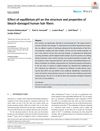TLDR Plant surfactants from quinoa and soybeans are effective, safe, and eco-friendly for shampoos.
The study investigates the use of plant surfactants from Chenopodium quinoa, Glycine max, and Malpighia emarginata in shampoo formulations, emphasizing their eco-friendly and hypoallergenic properties. These natural surfactants demonstrated stability, low toxicity, and effective cleaning potential, with surface tension reduction to 27.1–31.7 mN/m and interfacial tension to 5.4–7.3 mN/m. The formulations maintained standard ranges for various properties and showed sebum removal capacity comparable to or better than commercial shampoos. The study suggests that these plant-derived surfactants could effectively replace synthetic surfactants, offering benefits for sensitive skin and environmental sustainability.
5 citations
,
August 2021 in “Journal of drug delivery and therapeutics” The herbal shampoo with fermented rice water is safe and effective for reducing hair fall.
 10 citations
,
September 2020 in “Biopolymers”
10 citations
,
September 2020 in “Biopolymers” Hair's structure and properties change with pH; acidic pH maintains strength and less swelling, while alkaline pH increases water content and swelling.
 3 citations
,
October 2018 in “International Journal of Green Pharmacy”
3 citations
,
October 2018 in “International Journal of Green Pharmacy” The herbal shampoo with Piper betle and Psidium guajava leaves extract promotes hair growth and improves hair health.
8 citations
,
January 2018 in “Journal of cosmetic dermatology” Conditioners in hair dye reduce damage and improve combability.
37 citations
,
October 2017 in “Saudi pharmaceutical journal” All evaluated shampoos meet Saudi standards.
77 citations
,
May 2017 in “Medicine” Understanding skin structure and function is crucial for grasping skin health and diseases.
 11 citations
,
January 2023 in “BioMed Research International”
11 citations
,
January 2023 in “BioMed Research International” Microbial biosurfactants could be a safer and environmentally friendly alternative to chemical surfactants in cosmetics.
 December 2024 in “Research Journal of Pharmacy and Technology”
December 2024 in “Research Journal of Pharmacy and Technology” Seablite root extract may help prevent hair loss and promote hair growth.
 9 citations
,
December 2022 in “Phytomedicine”
9 citations
,
December 2022 in “Phytomedicine” More high-quality research is needed to recommend flavonoids and saponins for clinical use.
7 citations
,
December 2021 in “Pharmaceutics” The nanoemulsion with garlic oil, apple cider vinegar, and minoxidil could effectively treat alopecia areata.
 13 citations
,
April 2019 in “American Journal of PharmTech Research”
13 citations
,
April 2019 in “American Journal of PharmTech Research” Emulgels effectively deliver hydrophobic drugs for skin conditions like acne and psoriasis.





